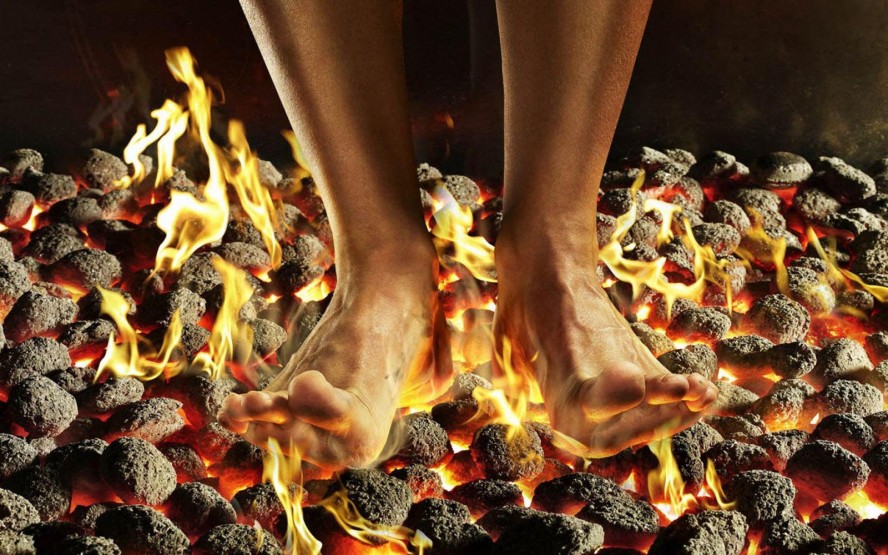I would like to share with you some thoughts on walking meditation, particularly the link that can be made between the walking exercise and the management of the five poisons or kleshas in the mind. How do we transmute the five poisons into their “awakened aspects” known as the five wisdoms?
The first of the five kleshas is mental opacity or lack of discernment. You can compare it to a large foggy space. The space and its qualities are not recognized. When we walk, we are taking the measure of space. We become aware of our position in space and its wealth as the source of all the possibilities: walking, sitting, standing. A type of repossession happens, a new discovery of space; its qualities and our own position in it.
The next poison is anger or irritability, it is the result of fear born from ignorance. Like someone walking in a forest who is fearful of the moving leaves, the reflection of the moon, unknown noises. In this state of fragility anything aggravates us. Whenever sources of irritability arise, we come back to this step, this breath and posture as anchor points. We can see that these aggravating stimulations are merely ghosts born of mind. We understand their illusory nature as what we see in a mirror: an image, a reflection without self-reality. We can free ourselves from the old reflex to gulp the bait of stimulation. This is what makes us nervous or irritable. This becomes obvious when we walk carefully. As we observe the mind, we see that it is constantly irritated or bothered by something; “this is not what I want” or “this is not how things should be.” Walking does us good!
Then there is the neurotic need to single ourselves out. Since who we are is not entirely clear to us, we must pretend like the toad who is afraid and inflates! We feel the need to take up a lot of space. There is an urgency to respond to uncertainty with arrogance, to project a bigger and more powerful image of oneself into the world. Walking meditation reveals this, then we simply come back to the step; breath; posture. We come back to a simplicity that brings humility; we are all walkers, we walk the same pace. We are moving and we do not particularly need to be singled out. There is no danger. The reminder of meditation, by the return to the step releases all sources of irritability. The need to feel special, which is brought on from fear, vanishes.
On the other hand, sometimes we feel like we are disappearing in the anonymous mass, in a sort of denial of biodiversity. Even though there is the essential equality of Buddha Nature in all walkers, there are also specificities. There are men and women, differences in age and body size, but also differences in the mind and the way of going through an experience, etc. We are all unique. It is important to look inside to discover our specific qualities. Otherwise we will be forced to fish outwardly for evidence of appreciation that confirms our existence. This constant external projection gives birth to an unquenchable greed. The desire to confirm our existence by the possession of mirror-like outer objects is constantly stirring a thirst that nothing can appease.
With walking, one can appreciate what is: “I am walking, standing, free. In this moment, this very step, I have all the wealth, all the opportunity. I can think, I can breathe, I can touch the sky.”
Through the repossessing of space and the appreciation of the equanimity of all, our uniqueness becomes clear without the neurotic need to be recognized. Furthermore, we are able to protect our distinctiveness from the corruption into pride. Thus, greedy desire cedes the way for a genuine appreciation of everyone’s specific and generic qualities.
The last klesha is jealousy, competition. As noted above, if we do not exactly know ourselves we feel the need to differentiate. Thus appears the need to ensure our position and be ahead of (behead!) others. We are driven to be better than the “competitor” and compare ourselves to others in order to secure an enhanced self-image. During walking meditation we are simply a walker among walkers. We rediscover our breath, our step, our qualities. We realize that the specifics of each person are not comparable, like elephants and ants. There is therefore no classification possible. The fact that we all partake of Buddha Nature ensures an essential equanimity that each of us expresses in a specific way, which can lead to a harmonious interaction that makes competition obsolete. We form a circle. “Ah! Today I am the fourth in rank. ” What is the fourth pearl of the rosary? In a circle, there is neither first nor fourth pearl! All have equal value and at the same time, if you look, each of them has different colors and shapes. I am always behind someone and in front of someone. Even if I’m the first, I’m behind the last one! We have a place but not the need to be in front. No need to be either faster or slower. All these unnecessary comparisons form the synergy of the five kleshas which can be released by going back to the step, breath and posture; accepting one’s place. To accept to be where we are is not a resignation, it’s awakening.
What I have said about walking meditation also applies to sitting meditation. We are sitting in a circle with the same cushions, with varying thickness of blankets, but there is a true unity: we are all endowed with the nature of awakening.
(Editing: Wendelin Wagner. Thanks !)

